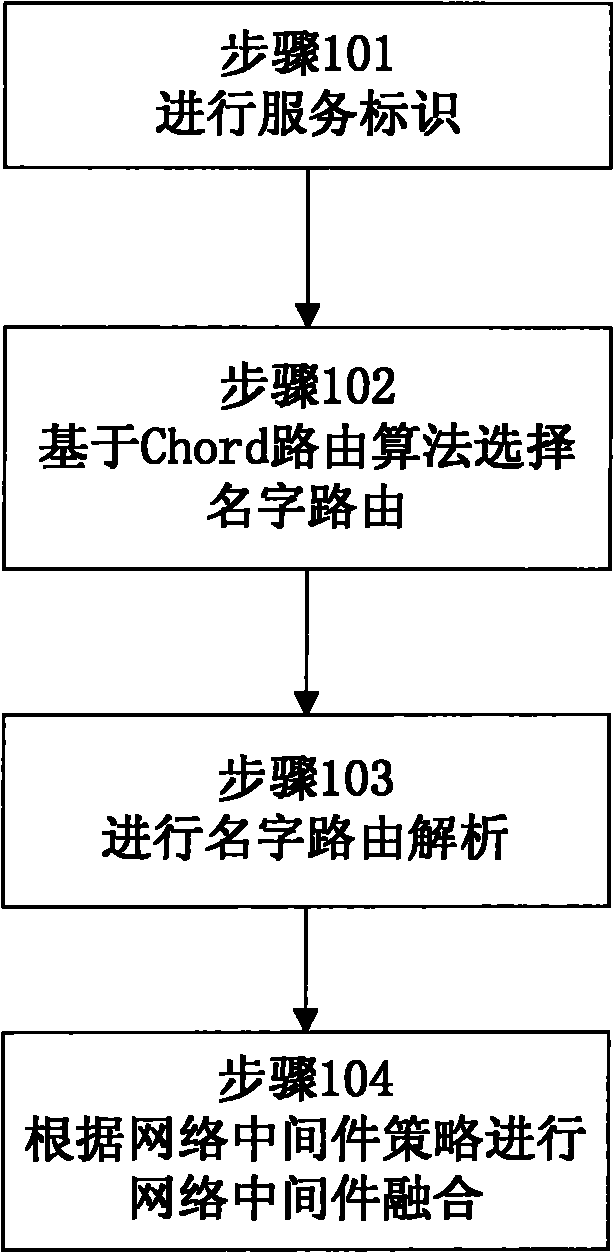Method for implementing fusion of network middleware
A technology that integrates networks and implementation methods, applied in the field of Internet communication, can solve problems such as destroying the Internet hierarchical structure, reducing Internet openness and transparency, etc., to ensure transparency, solve network business and security problems, and ensure openness Effect
- Summary
- Abstract
- Description
- Claims
- Application Information
AI Technical Summary
Problems solved by technology
Method used
Image
Examples
Embodiment 1
[0032] Embodiment 1 As an important network entity in the future Internet world, network middleware plays an important role in the Internet world. However, the application of network middleware often comes at the expense of destroying the hierarchical structure of the network, thus greatly challenging the openness and transparency of the Internet to new applications. To maintain the openness and transparency of the Internet, it is necessary to integrate network middleware into the network architecture. figure 1 It is a working flow chart of the implementation method of the converged network middleware according to a specific embodiment of the present invention, combining figure 1 As shown, in a specific embodiment, a method for implementing converged network middleware includes the following steps:
[0033] Step 101, perform service identification: use the Hash algorithm to assign a uniform and unique service identification for each resource to uniquely identify the resource,...
Embodiment 2
[0047] Example 2: In this example, figure 2 shows the packet format, image 3 shows the packet protocol header format, see figure 2 and image 3 As shown, the names and meanings of the fields in the data packet format and data packet protocol header format are as follows:
[0048] The service identification header is located between the IP header and the TCP header, and the service identification layer can be regarded as a sandwich layer between the network layer and the transport layer. The transport protocol header can be either TCP or UDP.
[0049] The "version" field indicates the version number of the mapping protocol; the "reserved" field reserves space for future applications; the 2-bit "T" field is used to indicate early resolution or late resolution, anycast late resolution or multicast late resolution, where 00 or 01 is used to represent early resolution, 10 represents anycast late resolution, and 11 represents multicast late resolution; the designed "destinati...
Embodiment 3
[0050] Embodiment 3: Name resolution is divided into early resolution and late resolution. Source routing can be regarded as early resolution, and hop-by-hop routing based on the routing table can be regarded as late resolution. The mapping system supports both early and late resolution. In the case of early resolution, the mapping system will return a series of connection information corresponding to the service ID for the application to choose. Late resolution is further divided into anycast late resolution and multicast late resolution, which perform routing based on service identifiers and forward data to corresponding service providers through the mapping server.
[0051] Such as Figure 4 As shown in the upper left, the process of early resolution is as follows:
[0052] Step 401, the client forwards the service identifier to the default mapping server;
[0053] Step 402, the mapping server forwards the request information to the mapping server storing the SID informa...
PUM
 Login to View More
Login to View More Abstract
Description
Claims
Application Information
 Login to View More
Login to View More - R&D
- Intellectual Property
- Life Sciences
- Materials
- Tech Scout
- Unparalleled Data Quality
- Higher Quality Content
- 60% Fewer Hallucinations
Browse by: Latest US Patents, China's latest patents, Technical Efficacy Thesaurus, Application Domain, Technology Topic, Popular Technical Reports.
© 2025 PatSnap. All rights reserved.Legal|Privacy policy|Modern Slavery Act Transparency Statement|Sitemap|About US| Contact US: help@patsnap.com



